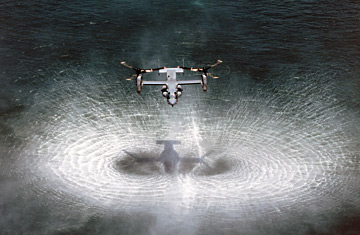
A V-22 flies over the Atlantic Ocean off the coast of North Carolina.
(4 of 4)
A former F-14 aviator, Carroll likens the V-22 to another Marine favorite, the AV-8 Harrier jump jet. "The Harrier," he notes, "is actually a good analogy for the V-22." Like the AV-8, the V-22 is a radical aircraft crammed with compromises that may change combat forever. And like the AV-8, it may also kill a lot of Marines while doing little of note on the battlefield. Since 1971, more than a third of Harriers have crashed, killing 45 Marines in 143 accidents.
But there's a critical difference between the two warplanes. Each Harrier carries a single pilot, nestled into an ejection seat with a parachute. But after all the debate about tilt-rotor technology--after all the vested interests have argued their case and all its boosters and critics have had their say--this much we know: within days, a V-22 will begin carrying up to 26 Marines into combat in Iraq, with no ejection seats--and no parachutes. Flight Risk After decades of trouble-plagued development, the V-22 Osprey is heading into a war zone. The Marines say the craft's problems have been fixed, but the critics say its design compromises could make it deadly for those on board [This article contains a complex diagram. Please see hardcopy of magazine.]
